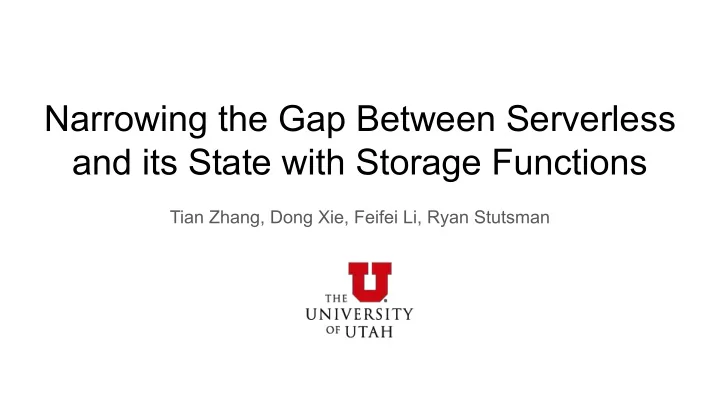

Narrowing the Gap Between Serverless and its State with Storage Functions Tian Zhang, Dong Xie, Feifei Li, Ryan Stutsman
Shredder ● A multi-tenant in-memory key-value store. ● Extensible with user-provided storage function. ● 5 M ops/s per machine, ~20 μs latency ● In-runtime data access method, able to access 10s of GB of data per second.
High growth of serverless computing
High growth of serverless computing
High growth of serverless computing
Advantages of serverless computing ● Fine-grained resource provisioning. Server Container Function/ Serverless
Advantages of serverless computing ● Fine-grained resource provisioning. ● On-demand scaling. λ Server λ λ λ λ Container Requests Function/ Serverless Time
Problems of serverless computing ● Shipping data to code paradigm. High latency λ Data Bandwidth bound Serverless Storage Function Service
Problems of serverless computing ● Shipping data to code paradigm. ● User pay for additional idle time. λ Data Serverless Storage High latency λ Function Service Data Bandwidth bound Serverless Storage Function Service Idle time
Narrowing the gap ~ 50 μs λ Network costs between servers Data
Narrowing the gap ~ 50 μs λ Network costs between servers Data ~ 20 μs λ Kernel bypass to reduce latency Data
Narrowing the gap ~ 50 μs λ Network costs between servers Data ~ 20 μs λ Kernel bypass to reduce latency Data > 2 μs λ Data Push code to data, process isolation cost
Narrowing the gap ~ 50 μs λ Network costs between servers Data ~ 20 μs λ Kernel bypass to reduce latency Data > 2 μs λ Data Push code to data, process isolation cost λ ~ 31 ns Data V8 runtime isolation, boundary crossing cost
Shredder design goals ● Programmability - flexibility to implement any custom logic. ● Isolation - functions should be safely isolated. ● High Density and Granularity - should support thousands of tenants. ● Performance - optimize performance as much as possible.
Why JavaScript ● Flexibility of general programming language. ● Easier to implement customized data structures and logics than SQL. Graph Functions Streaming Functions Matrix Functions
Shredder design ● Embedded V8 JavaScript V8 engine runtime to isolate functions. ● Data access through V8 builtins. V8::Context V8::Context V8::Context λ λ λ JavaScript ● Data store implemented C++ Data Data Data in C++ native code. ● Networking, data Data store management, etc. NIC
Problem: runtime exit costs add up ● Data access across boundary V8 engine from JavaScript to C++. ● Add up to a lot of overhead for V8::Context V8::Context V8::Context functions accessing lots of data. λ λ λ JavaScript C++ Data Data Data Data store NIC
One step further V8 engine V8::Context V8::Context V8::Context ● Direct and safe data access from serverless functions. λ λ λ ● Eliminate boundary crossing. ● Leverage V8 JIT compiler. Data Data Data JavaScript C++ Data Data Data Data store NIC
CSA to eliminate boundary crossing ● Implement data access builtin in CSA (CodeStubAssembler), the V8 internal IR. ● Eliminating boundary crossing to C++. ● Runtime can inline CSA to improve performance. CSA TF_BUILTIN(HTGet, Hashtable λ CodeStubAssembler) { .... }
Data store and CSA builtin co-design ● CSA builtin and data store implement the same data lookup logic over shared data. CSA TF_BUILTIN(HTGet, λ CodeStubAssembler) { .... } C++ Hashtable db_val_t* ht_get(hashtable_t* ht, NIC uint32_t key) { .... }
Threat Model ● V8 contexts ensure fault isolation and no cross-tenant data access ○ Data is never shared across tenants ● TCB includes store, networking stack, OS, hardware, and V8 runtime ● Speculative execution attacks complicate secrecy ○ Users could craft speculative gadgets ○ Speculative gadgets could transmit restricted state through cache timing side channel ○ Landscape of attacks still evolving; unclear if runtime/compiler will be able to resolve them ● For now, a shared storage server is only safe with some mutual trust ○ Two-level isolation model possible ○ Process per-tenant; different functions in different runtimes
Evaluations ● 2 x 2.4 GHz Xeon with total 16 physical cores. ● 64 GB memory. ● Intel X710 10GbE. ● DPDK for kernel bypass.
Reduce data movements over network ● Projection , queries the first 4 bytes of a value. ● Pushing projection to Shredder reduces data movements, compared to baseline which fetches each whole value.
Data intensive functions ● Traverse Facebook social graph. ● Shredder 60X better performance. ● Access 10s of GB of data per second. ● CSA brings 3X performance gain.
Compute intensive functions ● Neural network inference functions. ● Shredder at disadvantage for compute intensive functions. ● Performance gain still possible if reduces enough data movements to offset inefficiency of JS code.
Related works ● Extensible stores: ○ Comet: An active distributed key-value store. OSDI 2010. ○ Malacology: A Programmable Storage System. EuroSys 17. ○ Splinter: Bare-Metal Extensions for Multi-Tenant Low-Latency Storage. OSDI 18. ● Serverless state store: ○ Pocket: Elastic ephemeral storage for serverless analytics. OSDI 18.
Conclusion ● Gap between functions and persistent states is costly ● Moving functions to storage eliminates some overhead ● Runtimes lower isolations costs, but boundary crossings still add up ● Data-intensive functions benefit from tighter integration of code and data ● Key idea: embed storage access methods within runtime ○ Both storage server and functions can both access data at low cost ● Result: achieves 3X better performance with in-runtime data access. Thank you!
Backup Kernel bypass No kernel bypass
Recommend
More recommend